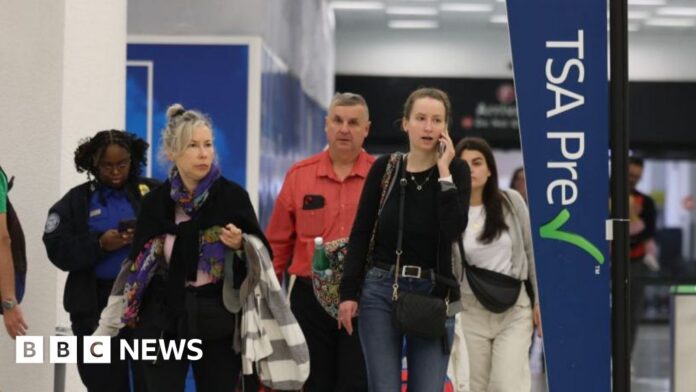The US federal government has shut down after Republican and Democratic lawmakers failed to resolve a budget standoff.
The impasse affects the funding of government operations through October and beyond, and is poised to cause widespread disruption for Americans in areas ranging from air travel to zoo visits.
The political gridlock is also expected to put 40% of the federal workforce – about 750,000 people – on unpaid leave.
This is how its impact could be felt across the country.
Your next flight
A federal shutdown could hit flyers in a variety of ways, potentially leading to long security queues, and delays caused by unpaid air traffic controllers choosing to stay home rather than work for free.
Air traffic control and Transportation Safety Administration (TSA) workers are considered “essential”, so they will continue to go to work.
But they will not be paid until the shutdown ends. When this last happened, in 2018-2019, these workers increasingly began to call in sick, leading to delays that had a ripple effect across the country.
Americans planning to travel abroad could also be impacted, with US passport agencies warning that it could take longer than usual to process travel documents.
No work – or pay – for federal workers
Federal employees are expected to be hardest hit, as they will not receive any pay cheques while the shutdown continues.
Law enforcement officers will continue to work through the government shutdown – though more than 200,000 of them will do so unpaid, Homeland Security Secretary Kristi Noem wrote on X.
Also continuing their work as usual are staff in border protection, including ICE agents (Immigration and Customs Enforcement), in-hospital medical care, and air-traffic control.
According to CBS News, the BBC’s US media partner, the five government departments with the most furloughed staff are:
- Department of Defense (civilian staff): 334,904 furloughed, 406,573 retained
- Department of Health: 32,460 furloughed, 47,257 retained
- Department of Commerce: 34,711 furloughed, 8,273 retained
- Department of State: 16,651 furloughed, 10,344 retained
- Nasa: 15,094 furloughed, 3,124 retained
Some workers may choose to take second jobs, as they have done during previous shutdowns. Employees that are not deemed to be essential will be forced to stay at home. In the past, these workers have then been paid retrospectively.
Several agencies, like the Centers for Disease Control and Prevention (CDC) and the National Institutes of Health (NIH) are likely to furlough many workers, affecting ongoing research and experiments already in progress.
President Donald Trump, who has slashed government spending and cut federal jobs since taking office, has warned repeatedly that a shutdown could accelerate further layoffs and allow him to cut services and programmes he says are important to Democrats.
Contractors who work for federal agencies but are not directly employed by the government will miss out on work, too. These workers historically have not received any back-pay, according to the Committee for a Responsible Federal Budget.
Members of Congress, however, will still be paid. They are protected under the US Constitution – a convention that has been opposed by some lawmakers.
National Parks with no staff
Federal lands, including National Parks and National Forests, have been closed off to visitors during past shutdowns, since the rangers and other employees were asked to stay at home.
During the last shutdown, the Trump administration made the decision to leave parks open, with few to no federal workers there to staff them.
According to park advocates, the decision led to vandalism in parks, as visitors drove through protected landscapes, looted historical sites, and rampantly littered.
A group of more than 40 former park superintendents have appealed to the White House to completely close the parks in the event of a shutdown.
“We don’t leave museums open without curators, or airports without air traffic controllers – and we should not leave our national parks open without National Park Service workers,” said Emily Thompson of the Coalition to Protect America’s National Parks.
Visit to the zoo
The famous Smithsonian Institution museums will stay open until at least Monday, 6 October.
On the Smithsonian website, the organisation said it had money available from years prior to help it keep operating.
Animals at the National Zoo “will continue to be fed and cared for,” according to the Smithsonian, which runs the zoo.
But the popular webcams will be shut off, as they have been deemed non-essential by zoo staff, so viewers won’t be able to peek at the pandas, lions, elephants and naked mole rats.
Healthcare for the elderly and poor
Medicare and Medicaid, social health programmes for the elderly and poor, will continue, but staffing shortages could lead to some interruptions.
Food assistance programmes will also be impacted, with the Supplemental Nutrition Program for Women, Infants, and Children (WIC) expected to rapidly run out of funds.
The Supplemental Nutrition Assistance Program (formerly known as food stamps) is expected to continue for longer, but is at risk of running out of funding.
Emergency disaster relief will also be largely unaffected, however other work done by disaster agencies will be impacted.
The National Flood Insurance Program will be closed, delaying some mortgages on properties that require policies from the government-run programme.
But if the shutdown drags out, it is possible that the Federal Emergency Management Administration (Fema) could run out of money for its Disaster Relief Fund.
Mail will still arrive
The US Postal Service has previously been unaffected by government shutdowns – and this time is no different.
In a statement posted on its website earlier this week, the service said all post offices would remain open for business as usual.
This is because the postal service does not depend on Congress for funding. It is an independent entity that is generally funded through the sale of its products and services, and not by tax dollars.


